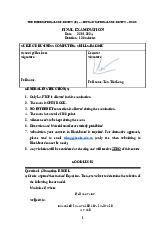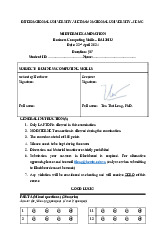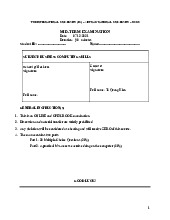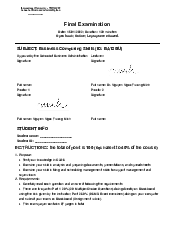




































Preview text:
Lecture 03 Computer Software
McGraw-Hill/Irwin
©2008,The McGraw-Hill Companies, All Rights Reserved Learning Objectives
1. Describe several important trends occurring in computer software.
2. Give examples of major types of application and system software.
3. Explain the purpose of several popular software packages
for end user productivity and collaborative computing.
4. Define and describe the functions of an operating system.
5. Describe the main uses of computer programming
software, tools, and languages. 4- 2 Types of software 4- 3 Software types • Application software
– Performs information processing tasks for end users • System software
– Manages and supports operations of computer systems and networks 4- 4 Application software • General purpose
– Programs that perform common information processing jobs for end users
– E.g., word processing, spreadsheet, etc.
– Also called productivity packages • Application-specific
– Programs that support specific applications of end users
– E.g., electronic commerce, customer relationship management, etc. 4- 5
Software classifications
• Classify based on how it was developed • Custom software
– Software applications that are developed within an
organization for use by that organization • COTS software
– Commercial Off-the-shelf (COTS)
– Software developed with the intention of selling the software in multiple copies
• Why would you choose Custom over COTS?
• Why would you choose COTS over Custom? 4- 6 Software Suites
• Software suites integrate software packages – Advantages:
• Cost less than buying individual packages • All have a similar GUI • Work together well – Disadvantages
• Features not used by all users • Take a lot of disk space 4- 7 Software Suites 4- 8 Integrated Packages • Integrated packages
– Combine the functions of several programs into one package
– E.g., Microsoft Works, AppleWorks – Advantages:
• Many functions for lower price and smaller disk space – Disadvantage • Limited functionality 4- 9 Web Browser
• Software applications that support navigation through
the point-and-click resources of the Web • Surfing the web
• Becoming a universal software platform for Internet- based applications
• Microsoft Explorer, Netscape Navigator, Firefox, Opera or Mozilla 4- 10
E-mail, Instant Messaging and Weblogs • E-mail
– Software to communicate by sending and receiving messages
and attachments via the Internet, intranet or extranet • Instant messaging (IM)
– Receive electronic messages instantly • Weblog or blog
– A personal website in dated log format
– Updated with new information about a subject or range of subjects 4- 11
Word processing and Desktop publishing • Word processing
– Create, edit, revise and print documents
– E.g., Microsoft Word, Lotus WordPro and Corel WordPerfect • Desktop Publishing
– Produce printed materials that look professionally published
– E.g., Adobe PageMaker, Microsoft Publisher and QuarkXPress 4- 12
Electronic Spreadsheets and Presentation Graphics • Electronic Spreadsheets
– Worksheet of rows and columns
– Used for calculations and charts
– E.g., Lotus 1-2-3, Microsoft Excel, Corel QuattroPro • Presentation Graphics
– Convert numeric data into graphics displays
– Prepare multimedia presentations including graphics, photos, animation, and video clips
– E.g., Microsoft PowerPoint, Lotus Freelance, Corel Presentations 4- 13
Personal Information Manager and Groupware
• Personal Information Manager (PIM)
– Software for end user productivity and collaboration
– Store information about clients, schedules, manage appointments, manage tasks
– E.g., Lotus Organizer, Microsoft Outlook • Groupware
– Software that helps workgroups collaborate on group assignments
– E-mail, discussion groups, databases, videoconferencing
– E.g., Lotus Notes, Novell GroupWise, Microsoft Exchange 4- 14 Sources of Software 4- 15
Proprietary and Off-the-Shelf Software 6
Software : for sale/free/rent • Commercial software:
– proprietary software or package software
– Copyright : exclusive legal right
– Software license : the right to use
– You don’t buy software: you buy a license to use the
software under the terms of the licensing agreement
– Licensed to protect the vendor’s property right • Public-domain software
– not protected by copyright
– For ex: open source software 4- 17
Software : for sale, for free or for rent ? • Shareware
– distributed free of charge but requires users to make a
monetary contribution to continue using it • Freeware
– Copyright software that is distributed free of charge • Rentalware – The users lease software
• Pirated software # counterfeit software 4- 18 System software
• Software that manages and supports a computer system • System management programs
– Programs that manage hardware, software, network, and data resources
– E.g., operating systems, network management programs,
database management systems, systems utilities
• Systems development programs
– Programs that help users develop information system programs 4- 19 Operating System
• Integrated system of programs that
– Manages the operations of the CPU
– Controls the input/output and storage resources and activities of the computer system
– Provides support services as computer executes applications programs 4- 20



